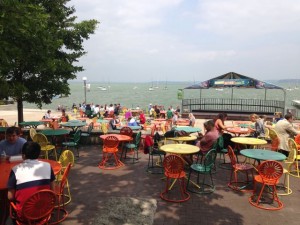I had an amazing day at the ARIS Summit at the University of Wisconsin, Madison today. First of all, if every have a reason to make a trip here, take it. Make excuses if you have to. It is a beautiful setting on the isthmus between Lake Mendota and Lake Menona. It has a number of “halls” (buidlings) dating back to the pre-Civil War days, a student’s union to beat all others, and loyalty to the Badger brand in the logo, crest and apparel of everyone walking around that is remarkable.
The summit is a part of the national Games+Learning+Society Conference hosted annually in Madison. If you are interested in the effects of play on learning, and gaming in all forms from cards, boards and mobile media -this is where you want to be every July.
ARIS stands for “augmented reality for interactive storytelling.” It was developed at UW, Madison and an extended group of committed colleagues at other institutions across the U.S. as an open-sourced platform for creating mobile games, tours and interactive stories. Every year, host David Gagnon of the Wisconsin Institute of Discovery (WID: a community that studies information at the intersection of research, education and business ) and his team host a summit to bring together folks world-wide who use ARIS in some context of learning.
Today was informational, transformative and inspiring. It started with an update from the developers outlining the new implementation of the game editor and the inclusion of ARIS into into the Field Day Lab, WID’s interdisciplinary team of educators, researchers, software engineers, artists and story tellers.
This was followed by a live Skype broadcast session with research fellows, Eleni Kolovou and Maria Saridaki from Greece who outlined the INVOLVEN program, a European Lifelong Living Program (LLP) spanning 5 nations that focuses on intergenerational storytelling through classroom-, location- and web-based experiences focusing on conservation efforts. Next, RIT’s Owen Gotltleib outlined Jewish Time Jump, a focusing on the enduring historical themes played through the narrative of a time traveling reported investigating about unrest among factory workers in early 20th century.
Harvard’s Amy Kamarainen and Shari Metcalfe demonstrated the potential of integrating virutal ecosystem game EcoMuve with augmenting a real field trip using EcoMobile, where Elementary students were able to learn about pond ecology before visiting a real swamp to perform specimen analysis, all done though ARIS. Before lunch, Nicolaas VanMeerten of the University of Minnesota showed how user analytics could be used to inform design decisions (just like in the NHL!)
In the afternoon session, Dana Atwood-Blaine of the University of Northern Iowa outlined her research investigating mastery learning using mobile learning and comparing the performance of boys and girls on STEM outcomes using ARIS at the hands-on science centre in Kansas City. Then it was my turn. I presented Dilemma 1944, my Second World War decision for enlistment game based on a narrative of Kitsilano students from the era. It was a bit un-nerving speaking in front of this crowd, but it went very well.
Phil Dougherty, Tim Lindstrom and Eric Church, all of UW outlined the complicated iterative process in creating a game on a grant budget in “Sustainable U.” The game can be played any time by students on campus to remind them of how to make good decisions about recycling and conserving energy. With their budget, they were able to hire graphic designers and animators to enhance the visual impact of their game while promoting mindful environmental practices among the student body.
In the final sessions, Denise Bressler of the Stevens Institute of Technology, Julie Oltman of Lehigh University demonstrated how iPads loaded with ARIS could enrich a grade 3 field trip to a farm; Charles Leffingwell showed how a similar system could be used in medical and nursing training; Tim Lindstorm outlined SIFTER, a geo-locative extension for ARIS that allows users to document and share images collect in field studies. Finally, Guatamala’s Elias Tzoc, a web developer for the Center of Digital Studies at Miami University in Ohio presented how ARIS was used to transfer a field activity into an augmented humanities-based game on Freedom Summer.
It was a full of information. We finished-up with a beer garden on the Tripp Deck of Memorial Union overlooking Lake Mendota.  My head was buzzing with questions as I exchanged thoughts and ideas with this exception group of people. Special shout-outs to David Gagnon, Chris Holden, Tim Lindstorm and Jim Matthews for their insights and comments. Special shout-out to Hallah Ghanem for putting it all together. I’ve still got 3 more days of the Games+Learning+Society Conference. It’s a bit overwhelming.
My head was buzzing with questions as I exchanged thoughts and ideas with this exception group of people. Special shout-outs to David Gagnon, Chris Holden, Tim Lindstorm and Jim Matthews for their insights and comments. Special shout-out to Hallah Ghanem for putting it all together. I’ve still got 3 more days of the Games+Learning+Society Conference. It’s a bit overwhelming.
Interested in game-based and mobile-media learning? This is ground zero.